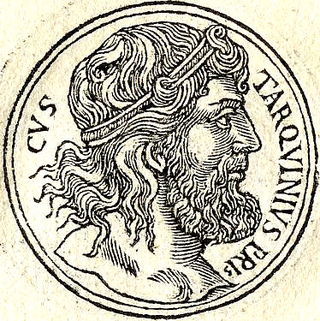
Lucius Tarquinius Priscus, or Tarquin the Elder, was the legendary fifth king of Rome and first of its Etruscan dynasty. He reigned for thirty-eight years. Tarquinius expanded Roman power through military conquest and grand architectural constructions. His wife was the prophetess Tanaquil.

Lucius Tarquinius Superbus was the legendary seventh and final king of Rome, reigning 25 years until the popular uprising that led to the establishment of the Roman Republic. He is commonly known as Tarquin the Proud, from his cognomen Superbus.
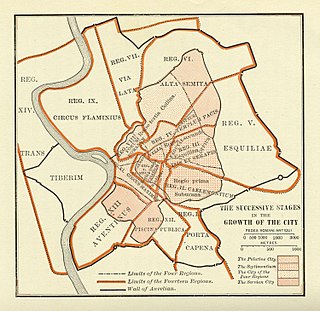
The Roman Kingdom was the earliest period of Roman history when the city and its territory were ruled by kings. According to oral accounts, the Roman Kingdom began with the city's founding c. 753 BC, with settlements around the Palatine Hill along the river Tiber in central Italy, and ended with the overthrow of the kings and the establishment of the Republic c. 509 BC.

Servius Tullius was the legendary sixth king of Rome, and the second of its Etruscan dynasty. He reigned from 578 to 535 BC. Roman and Greek sources describe his servile origins and later marriage to a daughter of Lucius Tarquinius Priscus, Rome's first Etruscan king, who was assassinated in 579 BC. The constitutional basis for his accession is unclear; he is variously described as the first Roman king to accede without election by the Senate, having gained the throne by popular and royal support; and as the first to be elected by the Senate alone, with support of the reigning queen but without recourse to a popular vote.
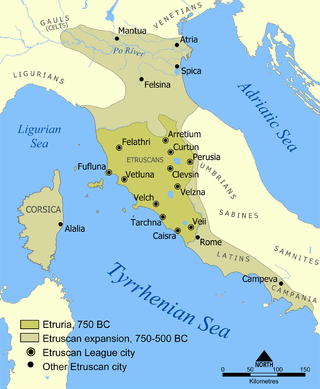
Etruria was a region of Central Italy, located in an area that covered part of what are now most of Tuscany, northern Lazio, and northern and western Umbria.
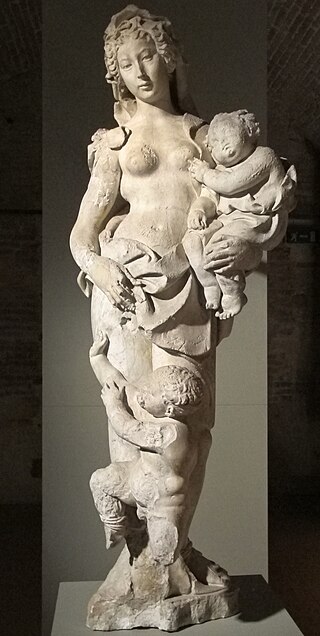
Acca Larentia or Acca Larentina was a mythical woman, later goddess of fertility, in Roman mythology whose festival, the Larentalia, was celebrated on December 23.

Fidenae was an ancient town of Latium, situated about 8 km north of Rome on the Via Salaria, which ran between Rome and the Tiber. Its inhabitants were known as Fidenates. As the Tiber was the border between Etruria and Latium, the left-bank settlement of Fidenae represented an extension of Etruscan presence into Latium. The site of the arx of the ancient town was probably on the hill on which lies the contemporary Villa Spada, though no traces of early buildings or defences are to be seen; pre-Roman tombs are in the cliffs to the north. The later village lay at the foot of the hill on the eastern edge of the high-road, and its curia, with a dedicatory inscription to Marcus Aurelius by the Senatus Fidenatium, was excavated in 1889. Remains of other buildings may also be seen.
Marcus Terentius Varro was a Roman polymath and a prolific author. He is regarded as ancient Rome's greatest scholar, and was described by Petrarch as "the third great light of Rome". He is sometimes called Varro Reatinus to distinguish him from his younger contemporary Varro Atacinus.
The Caelian Hill is one of the famous seven hills of Rome.
Demaratus, frequently called Demaratus of Corinth, was the father of Lucius Tarquinius Priscus, the fifth King of Rome, and the grandfather or great-grandfather of Lucius Tarquinius Superbus, the seventh and last Roman king.
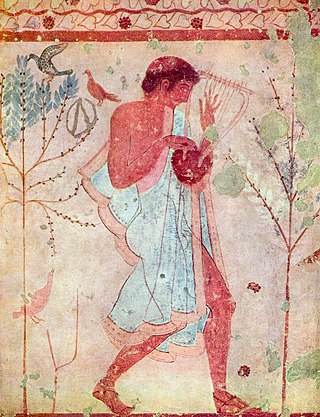
Lars Tolumnius was the most famous king of the wealthy Etruscan city-state of Veii, roughly ten miles northwest of Rome, best remembered for instigating a war with Rome that ended in a decisive Roman victory.

In ancient Roman religion, a sacellum is a small shrine. The word is a diminutive from sacrum. The numerous sacella of ancient Rome included both shrines maintained on private properties by families, and public shrines. A sacellum might be square or round.
Hostus is a Latin praenomen, or personal name, which was used in pre-Roman times and during the early centuries of the Roman Republic, but become obsolete by the 1st century BC. The feminine form was probably Hosta or Hostia. The patronymic gentes Hostia and Hostilia were derived from Hostus. The name was not regularly abbreviated.

The François Tomb is an important painted Etruscan tomb from the Ponte Rotto Necropolis in the Etruscan city of Vulci, Lazio, in central Italy. It was discovered in 1857 by Alessandro François and Adolphe Noël des Vergers. It dates to the last quarter of the fourth century BC. The tomb seems to belong to the Etruscan family of the Saties and one of its chief occupants is Vel Saties, who appears with his dwarf, Arnza.
The gens Caelia was a plebeian family at ancient Rome. The nomen Caelius is frequently confounded with Coelius and Caecilius, with some individuals referred to as Caelius in manuscripts, while appearing as Coelius or Coilius on coins. Although the Caelii asserted their great antiquity, none of them attained any of the higher offices of the Roman state until the praetorship of Publius Caelius in 74 BC, and the first of this gens who obtained the consulship was Gaius Caelius Rufus in AD 17. The emperor Balbinus was a descendant of the Caelii.
Vegoia is a sibyl, prophet, or nymph within the Etruscan religious framework who is identified as the author of parts of their large and complex set of sacred books, detailing the religiously correct methods of founding cities and shrines, draining fields, formulating laws and ordinances, measuring space and dividing time; she initiated the Etruscan people to the arts, as originating the rules and rituals of land marking, and as presiding over the observance, respect, and preservation of boundaries. Vegoia also is known as Vecu, Vecui, and Vecuvia, as well as Vegoe; her name is also given as Begoe or Bigois.

The Roman expansion in Italy covers a series of conflicts in which Rome grew from being a small Italian city-state to be the ruler of the Italian peninsula. Roman tradition attributes to the Roman kings the first war against the Sabines and the first conquests around the Alban Hills and down to the coast of Latium. The birth of the Roman Republic after the overthrow of the Etruscan monarch of Rome in 509 BC began a series of major wars between the Romans and the Etruscans. In 390 BC, Gauls from the north of Italy sacked Rome. In the second half of the 4th century BC Rome clashed repeatedly with the Samnites, a powerful tribal coalition of the Apennine region. By the end of these wars, Rome had become the most powerful state in central Italy and began to expand to the north and to the south. The last threat to Roman hegemony came during the Pyrrhic war when Tarentum enlisted the aid of the Greek king Pyrrhus of Epirus to campaign in the South of Italy. Resistance in Etruria was finally crushed in 265–264 BC, the same year the First Punic War began and brought Roman forces outside of the peninsula for the first time.
The Terentii Varrones a branch of the gens Terentia in ancient Rome.

The overthrow of the Roman monarchy was an event in ancient Rome that took place between the 6th and 5th centuries BC where a political revolution replaced the then-existing Roman monarchy under Lucius Tarquinius Superbus with a republic. The details of the event were largely forgotten by the Romans a few centuries later; later Roman historians invented a narrative of the events, traditionally dated to c. 509 BC, but this narrative is largely believed to be fictitious by modern scholars.













